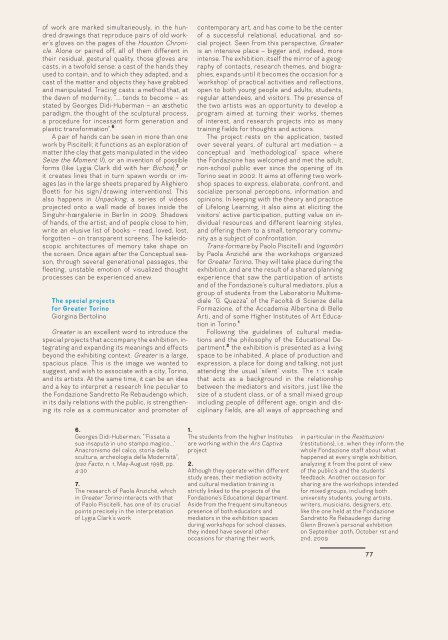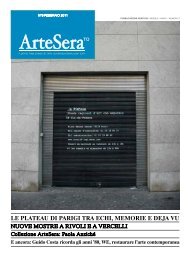Download Catalogue - Paola Anziché
Download Catalogue - Paola Anziché
Download Catalogue - Paola Anziché
Create successful ePaper yourself
Turn your PDF publications into a flip-book with our unique Google optimized e-Paper software.
of work are marked simultaneously, in the hundred<br />
drawings that reproduce pairs of old worker’s<br />
gloves on the pages of the Houston Chronicle.<br />
Alone or paired off, all of them different in<br />
their residual, gestural quality, those gloves are<br />
casts, in a twofold sense: a cast of the hands they<br />
used to contain, and to which they adapted, and a<br />
cast of the matter and objects they have grabbed<br />
and manipulated. Tracing casts: a method that, at<br />
the dawn of modernity, “… tends to become – as<br />
stated by Georges Didi-Huberman – an æsthetic<br />
paradigm, the thought of the sculptural process,<br />
a procedure for incessant form generation and<br />
plastic transformation”. 6<br />
A pair of hands can be seen in more than one<br />
work by Piscitelli; it functions as an exploration of<br />
matter (the clay that gets manipulated in the video<br />
Seize the Moment II), or an invention of possible<br />
forms (like Lygia Clark did with her Bichos), 7 or<br />
it creates lines that in turn spawn words or images<br />
(as in the large sheets prepared by Alighiero<br />
Boetti for his sign / drawing interventions). This<br />
also happens in Unpacking, a series of videos<br />
projected onto a wall made of boxes inside the<br />
Singuhr-hœrgalerie in Berlin in 2009. Shadows<br />
of hands, of the artist, and of people close to him,<br />
write an elusive list of books – read, loved, lost,<br />
forgotten – on transparent screens. The kaleidoscopic<br />
architectures of memory take shape on<br />
the screen. Once again after the Conceptual season,<br />
through several generational passages, the<br />
fleeting, unstable emotion of visualized thought<br />
processes can be experienced anew.<br />
The special projects<br />
for Greater Torino<br />
Giorgina Bertolino<br />
Greater is an excellent word to introduce the<br />
special projects that accompany the exhibition, integrating<br />
and expanding its meanings and effects<br />
beyond the exhibiting context. Greater is a large,<br />
spacious place. This is the image we wanted to<br />
suggest, and wish to associate with a city, Torino,<br />
and its artists. At the same time, it can be an idea<br />
and a key to interpret a research line peculiar to<br />
the Fondazione Sandretto Re Rebaudengo which,<br />
in its daily relations with the public, is strengthening<br />
its role as a communicator and promoter of<br />
6.<br />
Georges Didi-Huberman, “‘Fissata a<br />
sua insaputa in uno stampo magico…’<br />
Anacronismo del calco, storia della<br />
scultura, archeologia della Modernità”,<br />
Ipso Facto, n. 1, May-August 1998, pp.<br />
4-30<br />
7.<br />
The research of <strong>Paola</strong> <strong>Anziché</strong>, which<br />
in Greater Torino interacts with that<br />
of Paolo Piscitelli, has one of its crucial<br />
points precisely in the interpretation<br />
of Lygia Clark’s work<br />
contemporary art, and has come to be the center<br />
of a successful relational, educational, and social<br />
project. Seen from this perspective, Greater<br />
is an intensive place – bigger and, indeed, more<br />
intense. The exhibition, itself the mirror of a geography<br />
of contacts, research themes, and biographies,<br />
expands until it becomes the occasion for a<br />
‘workshop’ of practical activities and reflections,<br />
open to both young people and adults, students,<br />
regular attendees, and visitors. The presence of<br />
the two artists was an opportunity to develop a<br />
program aimed at turning their works, themes<br />
of interest, and research projects into as many<br />
training fields for thoughts and actions.<br />
The project rests on the application, tested<br />
over several years, of cultural art mediation – a<br />
conceptual and ‘methodological’ space where<br />
the Fondazione has welcomed and met the adult,<br />
non-school public ever since the opening of its<br />
Torino seat in 2002. It aims at offering two workshop<br />
spaces to express, elaborate, confront, and<br />
socialize personal perceptions, information and<br />
opinions. In keeping with the theory and practice<br />
of Lifelong Learning, it also aims at eliciting the<br />
visitors’ active participation, putting value on individual<br />
resources and different learning styles,<br />
and offering them to a small, temporary community<br />
as a subject of confrontation.<br />
Trans-formare by Paolo Piscitelli and Ingombri<br />
by <strong>Paola</strong> <strong>Anziché</strong> are the workshops organized<br />
for Greater Torino. They will take place during the<br />
exhibition, and are the result of a shared planning<br />
experience that saw the participation of artists<br />
and of the Fondazione’s cultural mediators, plus a<br />
group of students from the Laboratorio Multimediale<br />
“G. Quazza” of the Facoltà di Scienze della<br />
Formazione, of the Accademia Albertina di Belle<br />
Arti, and of some Higher Institutes of Art Education<br />
in Torino. 1<br />
Following the guidelines of cultural mediations<br />
and the philosophy of the Educational Department,<br />
2 the exhibition is presented as a living<br />
space to be inhabited. A place of production and<br />
expression, a place for doing and talking, not just<br />
attending the usual ‘silent’ visits. The 1 : 1 scale<br />
that acts as a background in the relationship<br />
between the mediators and visitors, just like the<br />
size of a student class, or of a small mixed group<br />
including people of different age, origin and disciplinary<br />
fields, are all ways of approaching and<br />
1.<br />
The students from the higher Institutes<br />
are working within the Ars Captiva<br />
project<br />
2.<br />
Although they operate within different<br />
study areas, their mediation activity<br />
and cultural mediation training is<br />
strictly linked to the projects of the<br />
Fondazione’s Educational department.<br />
Aside from the frequent simultaneous<br />
presence of both educators and<br />
mediators in the exhibition spaces<br />
during workshops for school classes,<br />
they indeed have several other<br />
occasions for sharing their work,<br />
in particular in the Restituzioni<br />
(restitutions), i.e. when they inform the<br />
whole Fondazione staff about what<br />
happened at every single exhibition,<br />
analyzing it from the point of view<br />
of the public’s and the students’<br />
feedback. Another occasion for<br />
sharing are the workshops intended<br />
for mixed groups, including both<br />
university students, young artists,<br />
writers, musicians, designers, etc.<br />
like the one held at the Fondazione<br />
Sandretto Re Rebaudengo during<br />
Glenn Brown’s personal exhibition<br />
on September 30th, October 1st and<br />
2nd, 2009<br />
77



